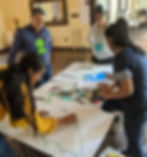Bridging the Gap Over the Guatemala-Honduras River Divide
- creativeactionins
- Mar 15, 2024
- 3 min read
Updated: Mar 18, 2024

“In my experience, leading our Creative Environmental Leadership Course over the last decade, whenever we have participants from environmental organizations in Guatemala and Honduras, there is usually an implicit blame related to the marine pollution caused by the Motagua river, affecting both countries,” shares Isabel Carrio, Creative Action Institute’s Project Manager for the region.

To give some context, the Motagua River pollution has been a polemic issue between Guatemala and Honduras for many years now. The 300-mile river originates in Guatemala, passes through eighty municipalities, and deposits out into the Honduran Caribbean coast. Over five million people live along its banks and, due to a lack of a national waste management system, dump their trash into it. In other words, it is a never-ending machine of trash deposited into the ocean.
The Caribbean coastal town of Omoa, Honduras, near the mouth of the river, collects around sixty tons of garbage per day that is deposited on their shores from the Motagua river. This includes plastic bottles, utensils, Styrofoam, plastic bags, clothing, toys, dead animals, and more.
In addition to solid waste, there is also the toxicity caused by chemical and sewage waste, carried by the river. The people of coastal communities are affected by the daily barrage of trash and the health of the ocean and marine life is also severely impacted: sea turtles choke on plastic waste, coral reefs are killed, among many other disastrous effects.

This is a contentious issue between the two countries, including a lawsuit from Omoa, Honduras against the Municipality of Guatemala in 2022. The same blame and distrust demonstrated between adults and authorities between Guatemala and Honduras is also reflected in the attitudes of youth. But this division is not always helpful for creating solutions or for organizing communities to act collectively for the common good.
The waste affects not just Honduran communities, but Guatemalan coastal communities as well - communities like El Quetzalito, Guatemala, which is on the other side of the river, facing Omoa.

To encourage participants to collaborate and learn from each other, Isabel says of last year’s course, “we intentionally placed two environmental leaders from El Quetzalito, Guatemala and from Omoa, Honduras together to work on a root cause and solution tree activity around the pollution of the Motagua river. As a result of that positive collaboration, the two participants decided to lead a bi-national Creative Advocacy Practicum (CAP) with us to initiate a dialogue between youth in the two countries most affected by the river.”
Marielos, from the organization Fundación Mundo Azul in Guatemala, and Laura, from the IDAMHO organization in Honduras, led simultaneous CAPs with youth in their home countries to understand the larger context of the river’s contamination and how and why it affects their coastal communities. Throughout the process, youth from both communities shared letters, videos, drawings, thoughts, and experiences with each other to produce solutions together.

Before the CAP, the youth did not fully understand where the trash came from, where the river starts, where it passes through, and that their communities were on the final receiving end of a much larger problem. Through analysis, discussion, and conversation, their eyes were opened to this larger issue. Rather than placing blame on one another, the exchange of letters and videos among the youth facilitated their realization that they are not adversaries, but rather, share a common cause.
As a culmination of their work together, youth in both communities painted public murals in their towns to educate others on the importance of caring for the environment, properly disposing of trash, eliminating single-use plastics, and to push for greater action on the part of authorities.
"The activity that I liked the most was when we made the letters and drawings for the youth of Honduras, because, through them, we were able to see that not only are we young people in Guatemala affected by the heavy pollution, but they are as well," shares Darwin, a participating youth from El Quetzalito.

This CAP was the first time that young people were engaged in the issue of the contamination caused by the Motagua river. Engaging youth in environmental issues and solution creation is vital to ensure the future of their communities, and of the planet.
As a result of the CAPs, over 1,000 community members in both El Quetzalito and Omoa were educated on marine pollution, its causes, and ideas for protecting their environment. In addition, local schools started recycling programs and educating their students about environmental conservation and waste management; local authorities agreed to involve youth in municipal committees to lead other environmental projects, such as reforestation and educational initiatives; and this project initiated a cross-country partnership, not only between the youth participants, but also between the two environmental organizations who led the CAP.
Learn more and watch videos about the implementation of these two CAP projects by following the links below:
